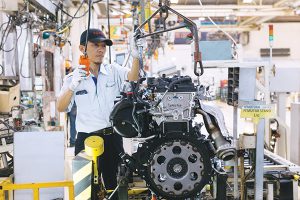If you’re thinking of investing in obscure battery materials to take advantage of the energy transition, there’s one company you should be watching right now: Zhejiang Huayou Cobalt Co.
Shares in the Shanghai-listed business have soared four fold over the past three years, to the point that it’s now worth more than Nippon Steel Corp., until recently the world’s third-largest steelmaker. What’s more important, though, is how it’s been spending its money.
Prices of the metals used in cathodes for electric vehicle batteries have been on a run in recent months. Huayou’s key product is cobalt, which prevents high-performance cells from overheating and is changing hands for $80,000 a metric ton in Shanghai — almost twice its level 12 months ago. It’s also heavily involved in supplying nickel, which helps pack more energy into the battery itself and this month hit $24,028 a ton, its highest in more than a decade.
Those bubbly prices are based on expectations that there’s insufficient raw materials out there to match demand growth for electric vehicles, something that’s also been driving a run in lithium. About one in five cars sold in Europe and China in the September quarter of last year were plug-in varieties, a share that will only rise as battery costs fall. Cobalt demand will more than double to more than 300,000 tons a year over the current decade, according to BloombergNEF. Swathes of Europe, North America and Asia plan to phase out petroleum-powered cars altogether during the 2030s.
The problems with cobalt, nickel are well-publicised. About 70% of world’s cobalt is mined in the Democratic Republic of Congo, where about a fifth of output comes from small-scale mines. Abundant nickel laterite ores, which are mined in vast quantities from tropical soils of Indonesia, the Philippines, and New Caledonia, are used for lower-quality products such as stainless steel and were traditionally considered unsuitable for turning into battery-grade nickel.
Huayou Cobalt and a handful of other Chinese investors in eastern Indonesia have been trying to change that. As luck would have it, laterite ores have almost exactly the proportion of both nickel and cobalt that you need to make a high-performance EV cell. The problem was that the economics of using vast volumes of pressurised sulfuric acid to leach raw materials from such rock were so poor that major miners had more or less given up.
That’s where Huayou has an opportunity. Like many Chinese companies operating in strategic industries, it appears to defy the normal laws of corporate finance. While its market value has increased, the outflow of free cash over the 12 quarters through last September amounted to a cumulative $743 million. That cash drain has only accelerated in recent months as billions have been raised from lenders and spat back out into project development.
As those who watched the rise and fall of conglomerates such as HNA Group Co. and Anbang Insurance Group Co. know, Chinese companies in strategic industries with pliant lenders often have few limits on their spending. Huayou in December promised to pay some $422 million in cash for Prospect Resources Ltd.’s Arcadia lithium mine in Zimbabwe, a project that was almost worthless before an initial feasibility study was completed a few months earlier. Next to that outlay, the sums it’s planning to spend on Indonesian nickel projects seem modest.
Those projects are now coming on stream. Huayou started producing nickel-cobalt mix from its plant on the island of Sulawesi in
December.
Combined with a $2.1 billion Huayou factory on Halmahera island announced last May and a handful of other acid-leached laterite projects under development, that could be enough to flood the market over the coming five years. Macquarie Group Ltd. estimates they could add about 376,000 metric tons of battery-grade nickel and 37,000 tons of cobalt by the mid-2020s. That’s equivalent to about a quarter of current mine production for each metal, and more than enough to keep supply well ahead of demand that may be trimmed anyway as battery-makers tweak the chemical makeup of their cells. Should the acid-leach process finally prove itself, the electric vehicle industry will be able to tap almost limitless quantities of laterite ores scattered across the tropics.
For decades, the nickel market has been riven with waves of volatility as new processing methods shake up supply outlook. Compared to previous spikes, the current surge looks relatively modest — but in common with those earlier rollercoaster rides, it’s likely to lead to more metal on the market, at a cheaper price than ever before.
The transition to electric vehicles will certainly cause booming demand for key metals, but that need not drive up prices. Incremental improvements in mining technology will always end up nickel-and-diming commodity bulls’ boldest hopes.
—Bloomberg
David Fickling is a Bloomberg Opinion columnist covering commodities, as well as industrial and consumer companies
 The Gulf Time Newspaper One of the finest business newspapers in the UAE brought to you by our professional writers and editors.
The Gulf Time Newspaper One of the finest business newspapers in the UAE brought to you by our professional writers and editors.

